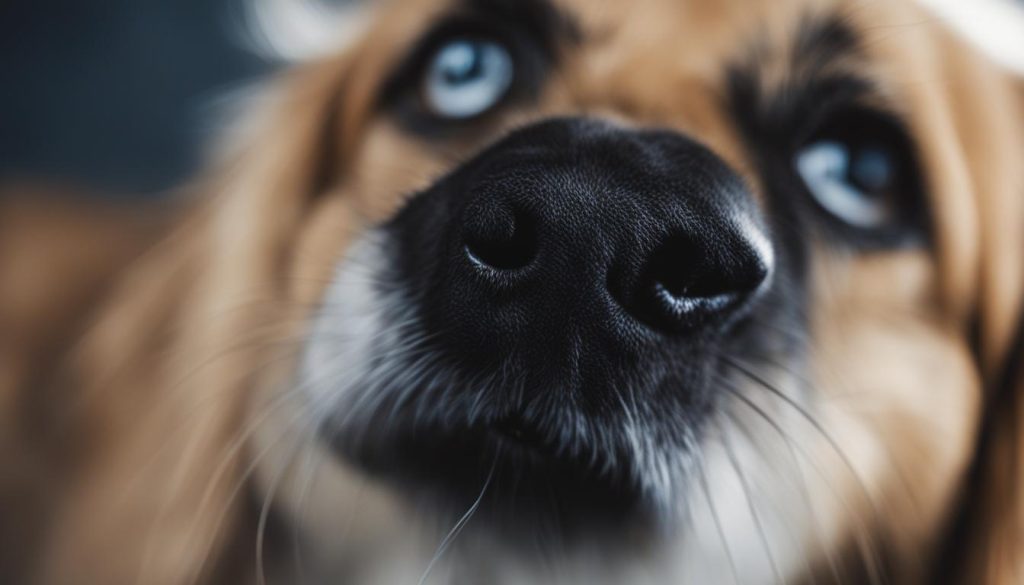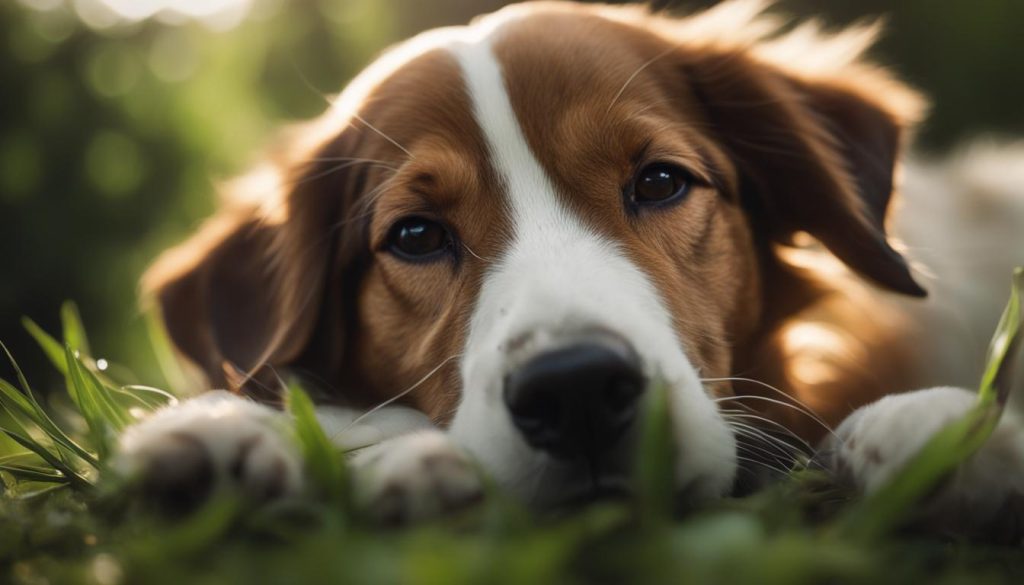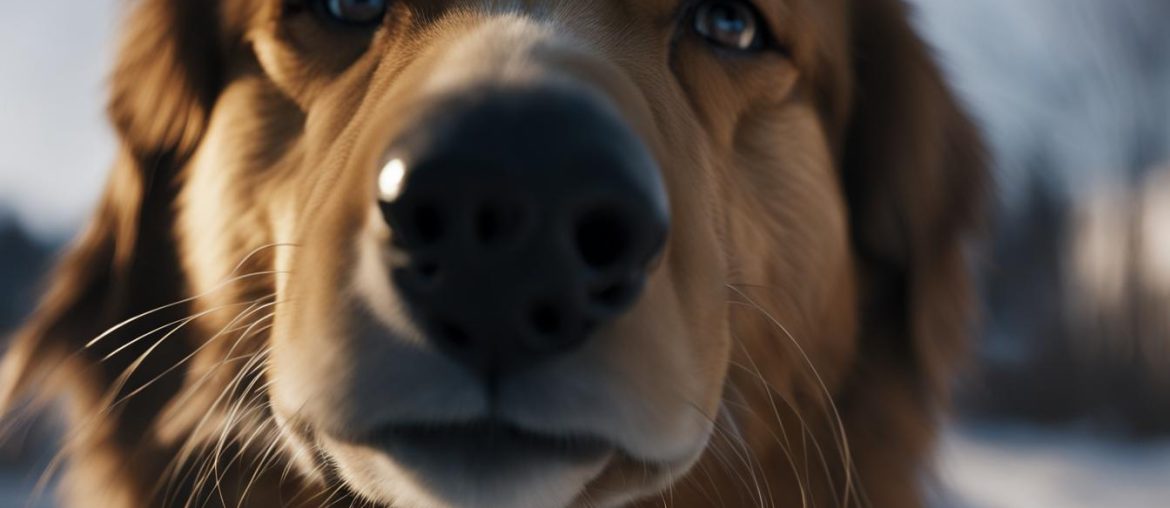Dog whiskers, also known as vibrissae, are specialized hairs that provide sensory information for dogs. Many dog owners wonder if their dog’s whiskers will grow back if they are accidentally trimmed or fall out naturally. In this article, I will explore the regrowth of dog whiskers and the important functions they serve in a dog’s life.
Whiskers are not just for looks; they serve important purposes such as detecting the size of spaces, protecting the eyes, and conveying information about health and mood. Understanding the role of dog whiskers can help us better care for our canine companions.
Key Takeaways:
- Dog whiskers, or vibrissae, are specialized hairs that provide sensory information for dogs.
- Whiskers serve important functions such as detecting the size of spaces and protecting the eyes.
- Dog whiskers shed and can grow back like regular hairs.
- Trimming or cutting dog whiskers can affect their functionality and spatial awareness.
- Caring for dog whiskers involves gentle cleaning and avoiding unnecessary manipulation.
Now, let’s delve deeper into the world of dog whiskers and discover why they are so vital to our furry friends.
Understanding Whiskers: What Are They and Where Are They Found?
Whiskers, or vibrissae, are specialized hairs that are unique to animals like cats and dogs. While we often associate whiskers with cats, dogs also have these fascinating sensory tools. Whiskers are stiffer and thicker than regular hairs and their follicles are embedded deeper in the skin, giving them a distinctive appearance.
When it comes to dogs, whiskers can be found in different locations on their face. The most prominent type of whiskers on dogs are the mystacial whiskers, which are located on the sides of their snout. These whiskers are usually longer and more noticeable. Dogs also have genal whiskers on their cheeks, supraorbital whiskers above their eyes, and interramal tufts under their chin. Each type of whisker serves a different function in helping dogs navigate and interact with their environment.
Understanding the different types and locations of dog whiskers is crucial in appreciating their role in a dog’s life. The delicate balance of these sensory tools enables dogs to gather essential information about their surroundings, enhancing their spatial awareness and overall perception of the world.

Table: Types of Dog Whiskers and Their Locations
| Whisker Type | Location on Dog’s Face |
|---|---|
| Mystacial whiskers | Sides of the snout |
| Genal whiskers | Cheeks |
| Supraorbital whiskers | Above the eyes |
| Interramal tufts | Under the chin |
The Functions of Dog Whiskers
Dog whiskers, or vibrissae, serve various important functions for our canine companions. These specialized hairs act as sensory tools, helping dogs navigate their environment and gather vital information about their surroundings.
Enhanced Navigation
One of the primary purposes of dog whiskers is to aid in navigation. These whiskers act as radar detectors, allowing dogs to assess the size of spaces and determine if they can fit through narrow openings. The whiskers provide valuable feedback about the dimensions of their environment, helping dogs avoid getting stuck or injured.
Sensory Tools
Whiskers also act as sensory tools, providing dogs with a wealth of information. They allow dogs to “see” in the dark by detecting subtle changes in air currents, helping them navigate and avoid obstacles when visibility is limited. Additionally, whiskers help dogs feel out objects and surfaces, providing a tactile understanding of the world around them.
Aiding Hunting Abilities
Furthermore, dog whiskers play a significant role in hunting. They help dogs detect prey by sensing even the slightest movements or vibrations in their environment, allowing them to locate and track potential targets. Whiskers provide dogs with a heightened sense of their surroundings, making them more effective hunters.

Overall, dog whiskers are not just decorative features; they are essential tools that contribute to a dog’s well-being. These specialized hairs enhance their navigation, act as sensory tools, and aid in hunting. You might want to understand and appreciate the functions of dog whiskers to ensure our furry friends can fully utilize their natural abilities for a fulfilling and enriched life.
The Importance of Leaving Whiskers Intact
Trimming or cutting a dog’s whiskers may seem harmless, but it can have detrimental effects on their well-being. Dog whiskers serve vital purposes, and interfering with them can disrupt their ability to navigate and communicate effectively. You might want to understand the importance of leaving whiskers intact and to refrain from any unnecessary trimming.
One of the main dangers of cutting dog whiskers is the impact it has on their spatial awareness. Whiskers act as sensitive receptors, providing dogs with valuable information about their surroundings. Removing or trimming whiskers can lead to confusion, uncertainty, and an increased risk of bumping into objects. Dogs rely on their whiskers to gauge the size of spaces, detect potential obstacles, and maintain a sense of their environment.
Furthermore, trimmed whiskers can affect a dog’s ability to communicate with other dogs. Whiskers play a significant role in social interactions, conveying emotions and signals to other canines. By trimming their whiskers, we hinder their ability to express themselves and understand the messages conveyed by their peers. This can potentially lead to social challenges and misunderstandings between dogs.
Table: The Impact of Trimmed Whiskers on Dogs
| Effects of Trimmed Whiskers | Consequences |
|---|---|
| Reduced spatial awareness | Increased risk of bumping into objects and accidents |
| Impaired communication with other dogs | Potential social challenges and misunderstandings |
To sum it up, it is vital to recognize the importance of dog whiskers and refrain from any actions that may compromise their functionality. Trimming or cutting dog whiskers can have significant consequences on their ability to navigate their environment and interact with other dogs. By leaving their whiskers intact, we ensure that our canine companions can lead fulfilling and comfortable lives, relying on their natural sensory tools.

Dog Whisker Regrowth: How Long Does it Take?
Accidents happen, and sometimes a dog’s whiskers may get accidentally trimmed or fall out naturally. But fear not, dog owners! Whiskers do have the ability to grow back, although the regrowth time can vary from dog to dog.
On average, it takes about two weeks for dog whiskers to start growing back. However, the exact duration of regrowth depends on the individual dog and the extent of whisker trimming or loss. Additionally, plucked whiskers may take longer to regrow and may not grow back at all.
Table: Regrowth Time for Dog Whiskers
| Type of Whiskers | Regrowth Time |
|---|---|
| Mystacial Whiskers (on the sides of the snout) | Approximately 2 weeks |
| Genal Whiskers (on the cheeks) | Approximately 2 weeks |
| Supraorbital Whiskers (above the eyes) | Approximately 2 weeks |
| Interramal Tufts (under the chin) | Approximately 2 weeks |
I highly suggest that you give the dog’s whiskers time to regrow naturally and avoid further trimming. Trimming or cutting a dog’s whiskers can disrupt their sensory abilities and hinder their overall well-being. So, if your dog’s whiskers accidentally get trimmed, be patient, and allow nature to take its course as their whiskers grow back.
To put it simply, a dog’s whiskers are not just decorative; they serve important functions in helping dogs navigate their environment. Let’s respect and care for our furry friends by leaving their whiskers intact.
Can You Trim Dog Whiskers?
Trimming dog whiskers is a topic of debate among pet owners and professionals in the grooming industry. While it is technically possible to trim dog whiskers without causing pain to the dog, it is generally recommended not to do so. Dog whiskers serve important sensory functions, and trimming them can impede a dog’s ability to navigate and communicate effectively. Even small trims can reduce the effectiveness of whiskers and may cause discomfort or confusion for the dog.
I would recommend to understand that dog whiskers are not like regular hairs. They are thicker, stiffer, and deeply rooted in the skin. Cutting or trimming them can disrupt the sensory information they provide, affecting a dog’s spatial awareness. Dogs rely on their whiskers to detect the size of spaces, protect their eyes, and feel out their surroundings. Removing or shortening these important sensory tools can have negative effects on a dog’s overall well-being.
If you are concerned about your dog’s appearance, it is best to consult with a professional groomer who understands the importance of preserving whiskers. They can recommend alternative grooming techniques that maintain your dog’s natural look while keeping their whiskers intact. By prioritizing the health and functionality of your dog’s whiskers, you can ensure that they can navigate their environment comfortably and confidently.
| Effects of Trimming Dog Whiskers |
|---|
| Disruption of sensory function |
| Reduced spatial awareness |
| Possible discomfort or confusion |
| Impact on overall well-being |
Expert Insight:
“Trimming dog whiskers may seem like a harmless grooming practice, but it can have significant consequences for dogs. Whiskers play a vital role in a dog’s ability to interact with their environment, and removing or trimming them can disrupt their spatial awareness and overall sensory experience.” – Dr. Emily Johnson, Veterinarian
Caring for Dog Whiskers
Dog whiskers, also known as vibrissae, are sensitive sensory organs that play a crucial role in a dog’s life. You should take proper care of these unique hairs to ensure the well-being and comfort of our furry friends.
Gentle Cleaning
Keeping your dog’s whiskers clean is essential for their overall health. If your dog’s whiskers get dirty, you can gently wipe them with a damp cloth followed by a dry cloth. Avoid using harsh chemicals or shampoos near the whiskers, particularly around the eyes and ears. You should be gentle and avoid unnecessary manipulation, as excessive touching or pulling can cause discomfort to your dog.
Regular Grooming
During grooming sessions, it is good practice to inform groomers and pet professionals about the importance of dog whiskers and the need to refrain from trimming or cutting them. Dog whiskers serve as vital sensory tools, and removing or trimming them can impede a dog’s ability to navigate and communicate effectively.
Overall Well-being
By caring for your dog’s whiskers and ensuring they remain intact, you are promoting their overall well-being. Whiskers aid dogs in spatial awareness, protection of the eyes, communication with other dogs, and even hunting. Recognizing the significance of dog whiskers and taking appropriate measures to care for them will help strengthen the bond between you and your furry companion.
To put it simply, caring for dog whiskers is a simple yet important part of your dog’s grooming routine. By following these tips and understanding the significance of dog whiskers, you can provide your canine friend with the care they deserve.
| Benefits of Caring for Dog Whiskers |
|---|
| Improved sensory perception |
| Enhanced communication with other dogs |
| Better spatial awareness and navigation |
| Protection of the eyes and face |

The Importance of Dog Whiskers
When it comes to our furry friends, dog whiskers often go unnoticed, but they play a crucial role in a dog’s life. These specialized sensory hairs are not just for show – they serve important functions that aid dogs in navigating their surroundings and communicating with others.
One of the key roles of dog whiskers is to provide sensory information about the environment. They act as radar detectors, allowing dogs to gather valuable information about the size of spaces, the presence of obstacles, and even the texture of surfaces. This information helps dogs make informed decisions and move through their surroundings with confidence.
Additionally, whiskers protect dogs by alerting them to potential dangers near their eyes and face. They can detect even the tiniest particles or irritants, preventing potential eye irritations or injuries. Moreover, dog whiskers serve as a means of communication between dogs. They can convey a dog’s emotions and signals to other dogs, enhancing social interactions and facilitating effective communication.
To summarize, dog whiskers are much more than just aesthetic features. They are vital sensory tools that enable dogs to navigate their surroundings, protect their eyes, and communicate with others. Recognizing the significance of dog whiskers can deepen our understanding of our canine companions and help us provide them with the care and respect they deserve.
Final Thoughts
To sum it up, dog whiskers, also known as vibrissae, are not just decorative features but serve crucial functions in a dog’s life. They act as sensory tools, providing dogs with information about their surroundings, helping them navigate their environment, and protecting their eyes from potential dangers.
I highly recommend dog owners to understand the significance of dog whiskers and refrain from trimming or cutting them. Trimming whiskers can impede a dog’s spatial awareness, causing confusion and discomfort. Therefore, it is best to leave dog whiskers intact and avoid any unnecessary manipulation or grooming.
Caring for dog whiskers involves gentle cleaning when necessary, using a damp cloth to wipe away dirt and avoiding the use of harsh chemicals near the whiskers. By recognizing the importance of dog whiskers and providing proper care, we can ensure the comfort and safety of our canine companions.
By appreciating the role of dog whiskers and their impact on a dog’s life, we can strengthen our bond with our furry friends and enhance our understanding of their needs. Let us respect the natural growth and functionality of dog whiskers, allowing them to fulfill their vital role in a dog’s sensory experience.
FAQ
Do dog whiskers grow back?
Yes, dog whiskers can grow back if they are accidentally trimmed or fall out naturally. The regrowth time can vary, but generally, whiskers can start to grow back in about two weeks. The exact duration of regrowth depends on the individual dog and how much was trimmed or lost.
What are dog whiskers and where are they found?
Dog whiskers, also known as vibrissae, are specialized hairs that are stiffer and thicker than regular hairs. They can be found in different locations on a dog’s face, including the sides of the snout (mystacial whiskers), cheeks (genal whiskers), above the eyes (supraorbital whiskers), and under the chin (interramal tufts).
What functions do dog whiskers serve?
Dog whiskers serve multiple functions. They act as radar detectors, providing dogs with information about their surroundings, such as detecting the size of spaces and feeling out objects in the dark. Whiskers also protect dogs by alerting them to obstacles and dangers, including dust particles or irritants near the eyes. Additionally, whiskers help dogs convey their emotions and signals to other dogs, and they can be helpful tools for hunting and tracking prey.
Why shouldn’t dog whiskers be trimmed?
Trimming or cutting dog whiskers is not advised as it can affect their ability to function properly and diminish a dog’s spatial awareness. Without intact whiskers, dogs may become uncertain, confused, and more prone to bumping into objects. Dog whiskers are important tools for dogs to navigate their environment, and removing them can impact their overall well-being.
How long does it take for dog whiskers to grow back?
The regrowth time for dog whiskers can vary, but generally, whiskers can start to grow back in about two weeks. The exact duration of regrowth depends on the individual dog and how much was trimmed or lost. You should note that plucked whiskers may take longer to regrow and may not grow back at all.
Is it possible to trim dog whiskers?
While it is technically possible to trim dog whiskers without causing pain to the dog, it is generally recommended not to do so. Dog whiskers serve important sensory functions, and trimming them can impede a dog’s ability to navigate and communicate effectively. Even small trims can reduce the effectiveness of whiskers and may cause discomfort or confusion for the dog.
How should I care for my dog’s whiskers?
Caring for dog whiskers is relatively simple. It is best to leave them untouched and avoid unnecessarily touching or manipulating them. If a dog’s whiskers get dirty, they can be gently wiped with a damp cloth followed by a dry cloth. Avoid using harsh chemicals or shampoos near the whiskers, especially around the eyes and ears. Inform groomers and pet professionals to refrain from trimming or cutting the dog’s whiskers during grooming sessions.
What is the importance of dog whiskers?
Dog whiskers play a crucial role in a dog’s life. They provide essential sensory information and help dogs navigate their surroundings. Whiskers aid in spatial awareness, protection of the eyes, communication with other dogs, and hunting. Dogs rely on their whiskers to understand their environment and make informed decisions. Recognizing the importance of dog whiskers can lead to a better understanding and appreciation of our canine companions.






